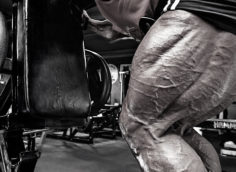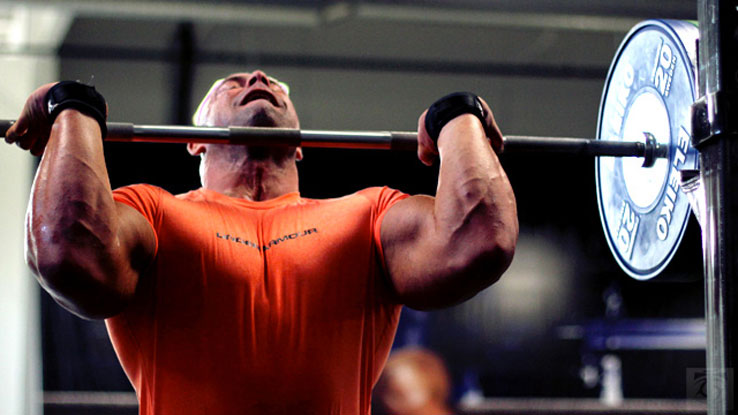Few people actually reach their desired goal when dieting. They plan to get shredded, but never get there.
It's not because of a lack of discipline or because the diet's not working, but because they weren't mentally prepared for the stumbling blocks to come. And when they DO come, most go off script, kill their progress, and stop their fat-loss effort altogether.
Here are things you need to know before you even start your diet. Being aware of them in advance will prepare you to face and overcome them.
This could be one of the main causes of dieting failure among those who don't just want to be lean, but also lean and muscular.
For many lifters, getting smaller can destroy motivation. When that happens, it's only a matter of time until the diet gets thrown out. After all, it's already bad to restrict your food intake; it gets even harder when you feel like you're not progressing toward your goal.
I call this stage the "dead zone" of body transformations. It's when you've lost enough fat, water, and glycogen to look and feel smaller, but not enough to look more defined.
It's also harder to get a pump. Your T-shirts may be loose. You may actually have less muscle definition. Your muscles aren't popping because they've become deflated from dropping water and glycogen.
You might even look fatter because the deflated muscles make you look softer. Don't worry though. This happens to everybody (though steroid users get it to a much lesser extent).
One of three negative things can happen:
- You lose motivation to stick to the diet, and you stop resisting the cravings.
- You make the conscious decision to stop the diet to avoid "wasting your muscle away".
- You decide to be even more extreme with your diet and exercise to "speed up" the process.
But unless you were doing something stupidly excessive to start with, you didn't lose muscle at that point, even if it feels like it.
If your protein intake is sufficient, your caloric intake is at a moderate deficit, and you're training at the proper level of effort, you really don't risk losing muscle until you reach around 8% body fat.
What's happening is that you dropped a lot of water from both inside the muscle and beneath the skin. Both make you look much bigger in clothes. It also helps you get a better pump.
Your glycogen stores are also significantly lowered, giving the illusion of muscle loss (like getting the air out of a balloon). The lower in carbs you go, the greater the impact.
A lot of people decrease sodium intake when dieting. Not on purpose, but because the foods they eat while dieting are much lower in sodium than some of the crap they normally eat. Decreasing sodium will make it harder to get a pump, decrease vascularity, and also make the muscles look flatter. That's why I keep sodium high when dieting.
When you get to the dead zone, and you will, you just need to keep your head down and trust the process. Just know it's coming and know why it's happening to avoid wrecking your efforts.

When dieting you should use lifting sessions to maintain or increase your muscle mass and strength. Lifting should not be used as a main fat loss tool. Still, there's a decent chance you'll lose strength on some lifts.
When you do, you may assume you're losing muscle, especially if you're feeling flat and small. In reality, this strength loss is related to something totally different than muscle loss.
It's caused by a decrease in passive stability. See, muscles can create stability in a joint. But you can also make a joint more stable by increasing pressure around it.
You increase pressure by packing more stuff around the joint. When your muscles are full of water and glycogen, there's more pressure around the related joint(s), so stability is increased without voluntary effort. Plus, extracellular water retention increases pressure around a joint too, making it more stable, and when there's more fat to cushion a region, that also increases stability.
Problem is, when you lose some of that while dieting, so some joints can become less stable. And this is important: when the body senses that a key joint involved in a lift is unstable, it won't allow you to use all of your strength potential. It limits force production because it doesn't feel safe.
The shoulder joint will be the most affected, mostly in pressing movements. As such, the bench press, incline bench, military press, and related lifts are the most likely to go down.
Heck, you could maintain your strength, or even increase it on isolation exercises for triceps, pecs, and delts, and still have a drop in your bench! That's because isolation exercises don't require the same stability. Also, since there's less loading on the joint, the body doesn't need to inhibit your performance.
The squat and its variations are the second most likely to be affected. Pulling exercises and even the deadlift are the least likely to be affected among the multi-joint movements.
That's why I like to do pressing in the Smith machine starting at around the halfway point of the diet. Because it's stable, the body will allow you to use a higher percentage of your force potential than in the free-weight bench. That's also why I like the hack squat machine at that time.
It's important to look at the big picture: if your big pressing movements and squat are going down a bit, but other exercises are staying up or even getting stronger, you're not losing muscle. You're just losing stability.
At my last photo shoot I was in great condition. Super lean, muscular, the best I've looked. Shirtless I looked very big because of the muscle definition. But when wearing a regular shirt, I looked much smaller than when I started the diet.
That's absolutely normal. If you lose 20, 30, or even 40 pounds, that's a lot of size you're removing from your body. It's unrealistic to think you'll occupy the same volume in space once you drop it, even if you kept all of your muscle.
I was reminded of this when I watched the TV show "Kingdom," a drama about MMA fighters. Jonathan Tucker, who played fighter Jay Kulina in the series, looked absolutely ripped and jacked in shirtless scenes, but when wearing a dress shirt, he looks small.

That's how it is when you get to very low levels of body fat, unless you're a true monster.
The key to reaching your body composition goal isn't about starting with the perfect diet, but rather making regular weekly adjustments.
If you start with a diet that has too many or too few calories, that won't cause a problem as long as protein is adequate and you make weekly adjustments to your caloric intake if you're not progressing at the desired rate.
Let's look at some examples:
Let's say you're in a fat-loss phase and select a diet that's a tad too low in calories. As a result, you lose "too much" weight: 5 pounds in your second week.
If you keep that pace, you'll quickly begin to lose muscle, have zero energy, sleep poorly, and have huge cravings. But in one week, none of that will happen and there will be no harm done provided you adjust your caloric intake to reach a more sustainable loss of 2-3 pounds per week.
The opposite could also happen. Let's say that despite being in what you thought was a caloric deficit, you don't lose any weight, or a minimal amount (one pound or less). You simply have to lower your caloric intake the next week.
The only thing you did was have one week where you didn't lose much fat, but in the grand scheme it won't prevent you from achieving your goal if you make the proper adjustments.
That's why it's important to measure your food. It's hard to make adjustments to your intake when you don't know what your intake is.
And this is super important: too much of a caloric deficit will eventually stop working. Why? Two main reasons:
- As you lose fat, your body has less mass to carry around. Having less mass to carry around diminishes the amount of fuel you need to move your body. This means a lowered caloric expenditure for the same activity level.
- There are metabolic adaptations that adjust your body to a certain level of nutrient intake if it's fairly constant.
The same can be said about muscle growth. As you put on muscle mass (and maybe some fat along with it) your energy expenditure increases. You need fuel just to support the added muscle mass as well as to carry the added body weight around.
As a result, a caloric intake that might be perfect at the beginning of your plan might becomes inadequate after a few weeks. Hence the need for monitoring and making adjustments. Use a tracking app like MyFitnessPal. You simply need to enter your food and their amounts, and it calculates everything.
How much fat you can lose weekly will vary depending on your size and how much fat you're starting with. A 110-pound woman with 15% body fat will have a lot less fat to lose than a 350-pound man with 35% body fat. She can't lose as much on a weekly basis, though two pounds per week is pretty well accepted and adequate for everybody but the outliers.
So a weekly loss of 1.5 to 3 pounds is acceptable. If you lose that in your week, maintain the same food intake for the next week.
Let's look at the table for the proper adjustments:
Fat Loss Phase Adjustments
| Body weight changes in the past week | Caloric adjustments |
|---|---|
| Losing more than 4.1 pounds | Increase calories by a factor of 2* |
| Losing 3.1 – 4 pounds | Increase calories by a factor of 1 |
| Losing 1.5 – 3 pounds | Stay the same |
| Losing 0 – 1.4 pounds | Decrease calories by a factor of 1 |
| Gaining 0.1 – 1.5 pounds | Decrease calories by a factor of 1.5 |
| Gaining more than 1.6 pounds | Decrease calories by a factor of 2 |
* A "factor of" refers to your bodyweight multiplied by the factor mentioned. For example, if you are 200 pounds and need to decrease calories by a factor of 2 it is bodyweight X 2 (or 200 pounds x 2). This would mean lowering your daily caloric intake by 400 calories.
You could just wing it. Those with tons of dieting experience can make pretty accurate dietary adjustments without measuring their foods and making precise adjustments. But for most of us it will be inefficient and risky (for muscle loss).
Do NOT lower calories by decreasing protein. Only fat and carbs should be decreased.

Both in terms of caloric adjustments and fat loss expectation, you should disregard the first week (mostly). Chances are, when you start a diet your body weight will drop a lot more in the first week than it will in any other week.
That's because initially you'll lose a lot of water weight and glycogen. By eating less food, you'll probably also carry less fecal matter, also lowering your weight. It's not unusual to lose 5-6 pounds or more in the first dieting week.
For example, in my current dieting phase I went from 230 to 223 in a week. But prior to that, I'd been force-feeding myself to get up to 230 and was holding a boatload of water: swollen ankles at night and no definition at all in my legs. In that first week I dropped all that water retention. My ankles went back to normal, separation came back in my legs, and I lost one head size.
That's an extreme case because I was eating crap food just to get enough calories. That crap food was pro-inflammatory which also led to water retention.
The next week I was down to losing 2.5 pounds at the same caloric intake. If I had made adjustments according to my first week, I would've stopped my fat loss on week two.
Another issue is creating bad expectations. Subconsciously you think if you lose 5 pounds that first week, you'll keep losing 5 pounds per week and you'll be ripped in 4 weeks. Doesn't happen like that!
That rapid weight drop in the first week is also one of the main reasons keto and carnivore diets are popular: even those who couldn't lose weight on a typical diet will drop a lot of weight on those plans. The lower the carbs are, the more weight you drop.
For someone who's always had a hard time losing weight, seeing scale weight 5 pounds in a week is addictive and they become a hardcore believer in the diet.
Certainly, if you don't drop weight at all in that first week, it's cause for concern, and you should go back to the drawing board because you should drop weight more easily in that first week. But don't let monster weight losses in week one cloud your judgment.
A young guy weighing around 220 pounds approached me because he wanted to do a bodybuilding competition. He had plenty of muscle and wasn't fat enough to look fat, but not lean either. It's a look you see a lot in most gyms.
He said he thought he'd be around 195 in contest shape. My answer was that he'd be 176 pounds in contest shape. He was in total disbelief. After all, he wasn't fat or out of shape. No way would he need to lose 40-45 pounds to be ripped!
Well, come contest day he was exactly 177 pounds. He also won the overall and looked amazing.
I've also worked with IFBB pro Patrick Bernard who would be 235 pounds in the off-season, with abs, and would compete at 195. A full 40-pound loss even though he had abs to start with.
Now, you may not want or need to look contest lean. But what I call "photo shoot lean" is only about 10 pounds short of a contest weight.
Most people make two mistakes when evaluating how much weight they'll need to drop to reach the look they want:
Mistake 1: They underestimate their body fat.
They guess it, and most people are at least 5% higher than they think they are. Listen, a true 10% body fat has full abdominal separation and decent definition and vascularity. If you're not at least very close to that, you're not 10, 12 or 13-14%.
If you're 200 pounds and in your mind you have 15% body fat and you want a look that's achieved at 8%, it's easy to think you only need to lose around 12 pounds. But since you likely carry a lot more fat than that, you'll find yourself far from your goal once you lose 12 pounds.
Even accurate caliper testing will give you a number that's around 3% too low because it doesn't include intramuscular, intra-visceral, and other internal fat deposits you'll lose during a diet.
From experience, most coaches "pinch thin" when it comes to calipers. I've seen plenty of guys test at 9-10% without the shadow of ab definition. Even calipers can mislead you.
Mistake 2: They don't account for the loss of other stuff.
Even if you accurately know how much fat you carry and how much you need to lose, it doesn't account for the fact that subcutaneous fat isn't the only thing you lose on a diet.
You drop glycogen, water, and intramuscular fat, among other things. For every pound of fat you need to lose, you'll also lose up to 0.5 pounds of "something else."
If you really have 20 pounds of fat to lose, in reality, scale weight will have to drop by around 30 pounds to look the way you want. And some people have a gross underestimation of body fat and overestimation of muscle mass.
If you don't have a precise body fat level measure, and if you've never dieted in the past, it's a mistake to have a precise number to shoot for.
For example, if you want to be 190 pounds at 8% body fat, it's a little silly. You don't even know if you have the muscle mass to carry a lean 190. Don't set expectations yet. Just follow the process and stop when you reach the level of leanness you desire without letting the number on the scale demoralize you.
Also understand that just because you assume you'd be "190 and ripped" and end up at 175 and ripped, it doesn't mean you lost 15 pounds of muscle. It's much more likely that you overestimated how much muscle you carried.
Achieving your fat loss goal is about mindset. You need to put blinders on, just keep pushing, and trust the process. There will be stuff thrown your way to get you off-course, but if you're aware of it before you even embark on the journey, your chances of overcoming them is much greater.
Being mentally prepared is the real secret to body composition changes.





